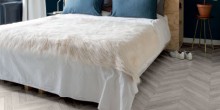
Introduction
When it comes to flooring options, the choice between vinyl and carpet is often a significant decision for homeowners. Both materials have their merits, and the decision ultimately boils down to personal preferences, lifestyle, and practical considerations. In this blog post, we'll delve into the key aspects of vinyl flooring and carpet flooring.
Aesthetics
Carpet flooring is renowned for its plush and cosy appearance, offering a warm and inviting atmosphere. However, carpet flooring can be prone to fading, staining and odour over time. Vinyl flooring comes in a wide array of styles and patterns, replicating the look of hardwood, tile, or stone. Its versatility allows homeowners to achieve the aesthetic they desire without sacrificing practicality.
Comfort
Undeniably, carpet provides a soft and cushioned surface underfoot, making it a popular choice for bedrooms and living areas. While vinyl might not match the softness of carpet, it provides a comfortable walking surface. Additionally, modern vinyl options often include underlayment for added cushioning.
Purpose
Carpet is an excellent choice for areas where comfort and warmth are priorities. However, fading away are the days of wall-to-wall carpet. Carpet in modern homes is mostly reserved for bedrooms and sometimes living rooms, but even so the soft flooring option is losing its traditional charm. Vinyl flooring, for its durability, versatility and low maintenance composition, has a wide application across many rooms of the modern home, including kitchens, wet areas like laundries and bathrooms, living rooms, bedrooms, living rooms, dining areas, and much more.
Acoustics
Carpet absorbs sound effectively, making it an excellent choice for spaces where noise reduction is crucial. While not as proficient in sound absorption as carpet, the acoustic performance of vinyl flooring can be enhanced by adding rugs or underlayment. This combination helps mitigate sound, making it a reasonable option for various spaces.
Durability
One of the primary drawbacks of carpet is its susceptibility to stains, wear, and tear. Liquid spills can easily penetrate carpet fibres, leading to long-term damage and a potentially shorter lifespan. Vinyl is highly resistant to stains and water damage, making it a durable option for households with pets or young children. Its resilience against heavy foot traffic ensures it maintains its appearance without showing signs of wear over time.
Maintenance
Carpet requires regular vacuuming and periodic professional cleaning to prevent the accumulation of dirt, allergens, and odours. Stains can be particularly challenging to remove, necessitating careful maintenance. Vinyl is low-maintenance; a simple sweep or mop keeps it clean. Its water-resistant nature makes it easy to wipe away spills, eliminating the need for extensive cleaning.
Lifespan
The carpet's lifespan varies but generally ranges between 5 to 15 years, depending on the quality and maintenance. Vinyl flooring has a longer lifespan, often 15 to 20 years or more, with proper care.
Cost
Carpet installation is generally more affordable upfront, making it an attractive option for budget-conscious homeowners. However, it's essential to consider the long-term costs associated with maintenance and potential replacement. While vinyl may have a slightly higher initial cost, its durability and low maintenance contribute to cost savings over time. Investing in vinyl is a more economical choice in the long run.
Conclusion
In the battle of vinyl flooring vs. carpet flooring, both have their merits. However, the practical advantages of vinyl, including easy maintenance, durability, and versatility, make it a compelling choice for many homeowners. Consider your lifestyle, preferences, and the specific needs of each room when making your decision, and you'll find the perfect flooring solution for your home.

 Filtered search
Filtered search






